It was expected that many southern Queensland regions would be too cold for fall armyworm (FAW) (Spodoptera frugiperda) to survive. However larval populations were found in the South Burnett and Lockyer Valleys, and small numbers of moths were also detected in pheromone traps on the Darling Downs this winter.
Caterpillars and moths in the South Burnett
In July, larvae were found in 15% of maize cobs in late maize on Kingaroy DAF Research Station. As well, low numbers of FAW moths (1-2 per week) were caught in the pheromone traps from June to August.
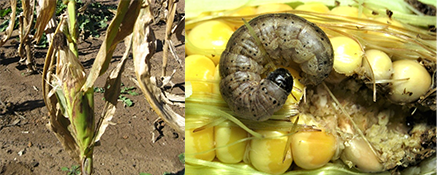
Late maturing cob in July and large FAW larva (23 mm) feeding inside this cob. Note the fall armyworm’s ‘greasy’ appearance (their colour can vary).
Other caterpillars found overwintering in cobs in low numbers were Helicoverpa armigera, false armyworm (Leucania loreyi), yellow peach moth (Conogethes punctiferalis), and sorghum head caterpillar Cryptoblabes adoceta.
- Helicoverpa
- False armyworm
- Yellow peach moth
- Sorghum head caterpillar
Pictured above are Helicoverpa armigera (24 mm) and false armyworm (21 mm) overwintering in late corn cobs at Kingaroy in July. The false armyworm is paler than FAW, and has a dark inverted Y on its head capsule. Note the darker spots on Helicoverpa’s 3rd body segment (from the head end). Yellow peach moth larva (14 mm) and sorghum head caterpillar (SHC) (9 mm) infesting late corn cobs in July. Yellow peach moth larvae look similar to bean podborer (Maruca vitrata) larvae (which don’t feed on maize). SHC are much smaller, only reaching 13 mm in length.
The obvious question is what will happen this spring? It is anticipated that FAW populations will be low initially, giving populations of beneficial predators and parasites time to build up and to take advantage of this new food source. And the later arrival of high densities of FAW (from local or other sources) would give early planted maize plants a chance to be more advanced (>V6), making them more able to tolerate FAW damage.
A major issue of concern in the Burnett is the large number of FAW in nearby warmer maize and sorghum growing regions, especially Central Queensland and the Coastal Burnett (Bundaberg). Year-round sweet corn plantings at Bundaberg have resulted in large numbers of FAW through winter (Figure 1), with hundreds of moths captured recently per week in traps located near sweet corn.
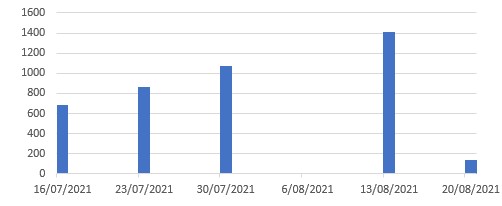
Figure 1. Bundaberg FAW moth trap catches during late winter 2021
Please report any suspicious damage in new maize, sweet corn or sorghum in the Burnett region to Hugh Brier (4182 1840 or [email protected]). Remember that small plants have a greater risk of critical stem damage leading to plant death, so look carefully for the initial signs of damage (see the Davis damage scale below), as small larvae are easier to kill.
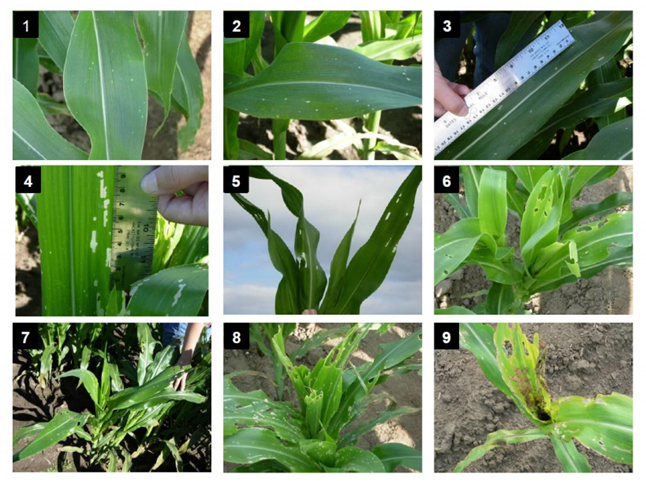
Davis FAW damage scale (1-9) for maize. Look for the first signs of lead windowing or tiny holes (plates 1-4) (source: page 11 of Plant Health Australia’s Fall armyworm continuity plan – grain).
Also please report any beneficial insect activity. Parasitoids and predators of note last season included Cotesia sp. wasps and carab beetle larvae.
- Cotesia pupae
- Carab larvae
Pictured above: pupae of Cotesia sp., a small wasp that can parasitise a single armyworm larva with 20 or more larvae, which visibly pupate beside their dying host, and right: a carab beetle larva attacking a small FAW larva, after killing a much larger FAW larva.
Darling Downs and Lockyer Valley FAW winter activity
An infestation of FAW was also found in the Lockyer Valley during winter. Large numbers of moths were recorded in the Gatton moth trap up until late May (Fig. 2). As a result of this activity, egg lays were found throughout May on late corn (although none were found in June). The resulting larval population survived through winter and eventually pupated in late July to early August. The first egg lay from this population was recorded in late August, a timeline consistent with model predictions of the rate of larval and pupal development (DARABUG) (Fig. 3).
What does this mean for the Lockyer Valley? We can confidently say that the valley had had a locally persisting population, meaning we won’t be waiting for an influx of moths from other regions; which was the source of FAW last season. At this stage, we are approximately one month ahead of last year’s immigrant infestation (first detected in early October). Because of this, it is likely that early planted crops will see FAW infestations, not just the later planted crops. With the cool weather (and lack of hosts), the infestations are likely to be small and patchy in the early spring-planted crops. However, checking crops from emergence is essential so management decisions can be made before larvae cause significant damage to crops.
This early infestation means that the Lockyer Valley will have one extra generation during the growing season (Fig. 3). The more generations a pest has, the greater the build-up in numbers. Consequently, the Lockyer Valley faces the prospect of higher densities by December-February than were seen last season. It is possible that we may also see better control and more natural enemy activity, which would reduce FAW population build up.
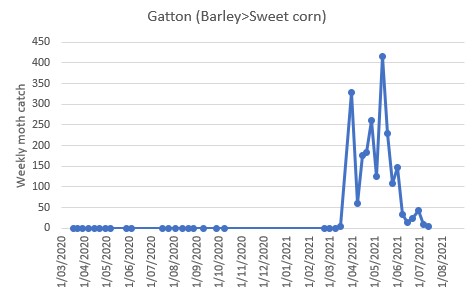
Figure 2. Gatton FAW moth trap catches March 2020 – July 2021. Trap located in barley over winter 2020, and then sweet corn at the DAF Gatton research station from spring 2020.
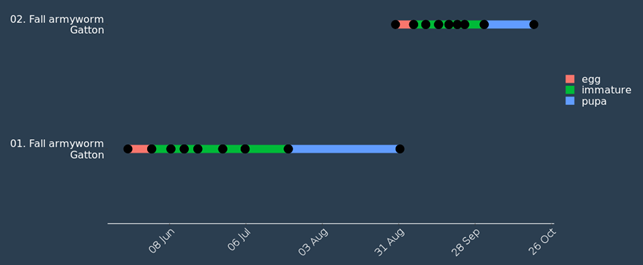
Figure 3. DARABUG model output for a FAW population in Gatton
In example 1 (Figure 3), the model output starts with the last recorded egg lay in late May (orange) and then predicts the rate of development of the resulting larvae (green) and pupae (blue). The model predicts moth emergence in late August, early September (approx. 100 days from egg to moth). If the moths emerging in early September start laying immediately, then example 2 shows the second generation developing much faster with the warmer temperatures expected in September and October (approx. 50 days from egg to moth).
A small number of moths were recorded in traps on the Darling Downs over winter (Figures 4 & 5). These moths either emerged from late sorghum or corn (development slowed by cool conditions) or are immigrants from elsewhere. There are no records of larvae surviving in crops over winter on the Downs, however given the similar climate to Kingaroy, a small population could survive. If FAW moths move from the Lockyer Valley to the Darling Downs, it would be reasonable to think that the moths will arrive slightly earlier than last year, so keep a close eye on early-planted crops.
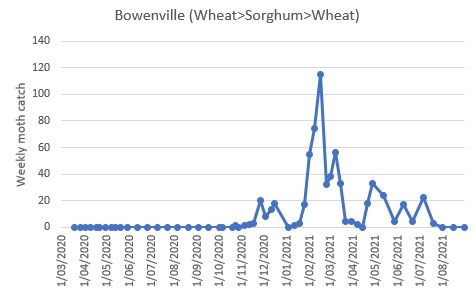
Figure 4. Bowenville FAW moth trap catches. March 2020 – August 2021.
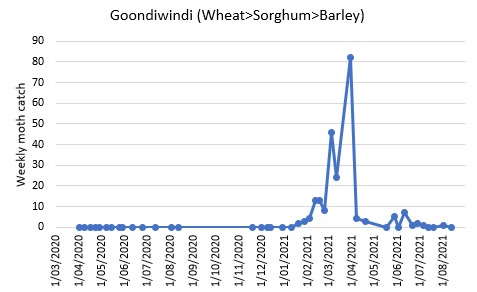
Figure 5. Goondiwindi FAW moth trap catches. March 2020 – August 2021.
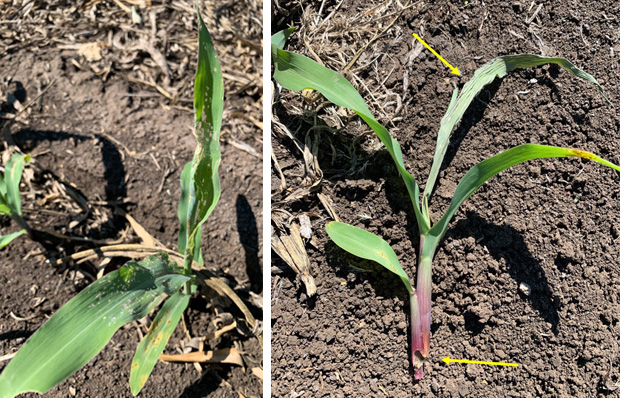
Signs of early FAW infestation in maize. (left) Small windows on the leaves indicate small larvae have been feeding. Examine the whorl for older larvae, or around the base of the plant if there is evidence of wilting, caused by larger larvae feeding at the base of plants (right).
Further information:
- View the FAW pheromone trapping weekly counts
- Try your own scenarios in DARABUG
Article by Hugh Brier and Adam Quade. Photos by Hugh Brier and Melina Miles.

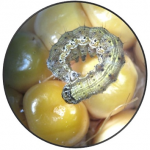
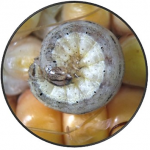

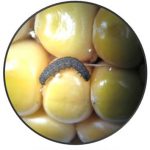
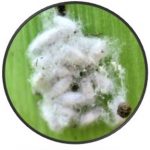
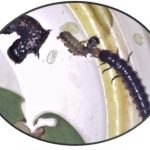
Thank you Hugh, Adam, and Melina. That is a really informative and well illustrated catch up of FAW status prior to what we anticipate will happen in the months to come. Important points I picked up are to hold off with the insecticides to let natural enemies get a foothold and to realize that not all caterpillars in maize and other crops are FAW.